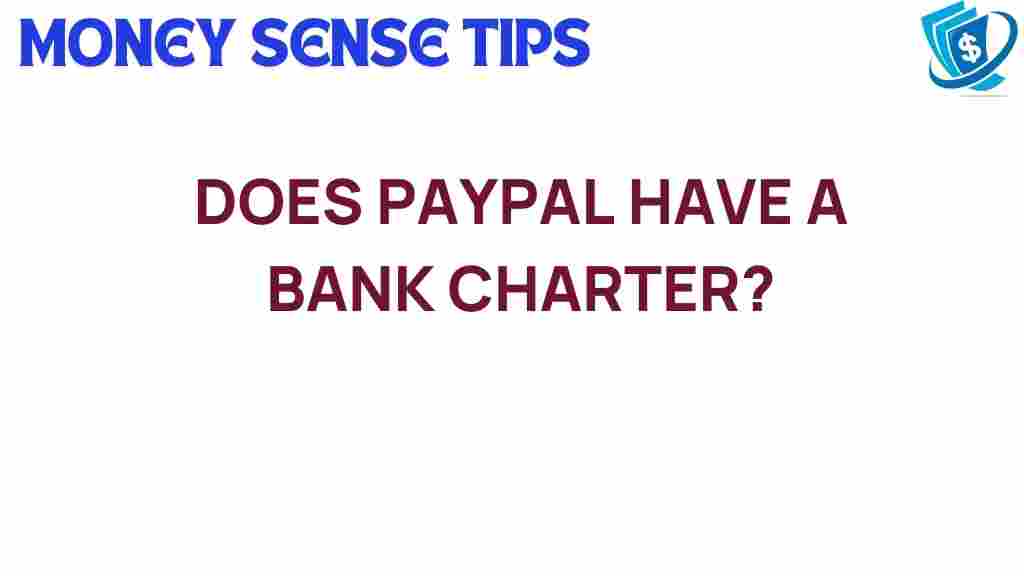The Hidden Secrets: Does PayPal Hold a Bank Charter?
In the rapidly evolving world of fintech, few names resonate as prominently as PayPal. With its user-friendly platform for digital payments and extensive range of financial services, PayPal has transformed the way we think about money transfer. But amidst its success, a question looms large: does PayPal hold a bank charter? Understanding this aspect is crucial to grasping how PayPal fits into the broader banking system and regulatory landscape.
Understanding Bank Charters and Their Importance
A bank charter is a legal document issued by a government authority that allows a financial institution to operate as a bank. It signifies compliance with regulation and the ability to offer a range of financial products, including deposit accounts, loans, and payment processing services. The implications of holding a bank charter are significant:
- Regulatory Oversight: Banks with charters are subject to rigorous regulatory scrutiny, which ensures they operate within the law and maintain financial stability.
- Consumer Protection: Bank charter holders often have to adhere to consumer protection laws, providing additional security for customers.
- Access to Federal Reserve Services: Banks with a charter can access services from the Federal Reserve, including the ability to borrow funds in times of need.
- Deposit Insurance: Chartered banks can offer federally insured accounts, which can attract more customers.
PayPal’s Evolution in the Financial Landscape
Founded in 1998, PayPal began as a digital wallet service, quickly gaining traction as a reliable platform for online payments. In the last two decades, it has expanded its services to include:
- Merchant Services: Enabling businesses to accept payments online and in stores.
- PayPal Credit: Offering credit lines for purchases.
- Peer-to-Peer Transactions: Facilitating easy money transfers between individuals.
With its rapid growth, the question of whether PayPal operates under a bank charter has become increasingly relevant. While PayPal does not hold a traditional bank charter, it has taken steps to compete in the financial services arena.
PayPal’s Banking Affiliations
Although PayPal itself does not have a bank charter, it has established partnerships with various banks to offer certain banking-like services. For instance, through its partnership with WebBank, PayPal can provide credit products and services to its users. This collaboration allows PayPal to function similarly to a bank without holding a charter itself.
Regulatory Landscape for Fintech Companies
The regulatory environment for fintech companies, including PayPal, is complex and varies significantly by region. Here are some key aspects:
- Licensing Requirements: Fintech companies often need to obtain specific licenses to operate, which may vary by state or country.
- Consumer Protection Regulations: Many jurisdictions impose regulations to protect consumers engaging in online banking and money transfer services.
- Anti-Money Laundering (AML) Compliance: Fintech companies must comply with AML regulations to prevent illicit financial activities.
How PayPal Operates in the Digital Payments Space
PayPal operates as a payment processor, functioning within a framework that allows it to provide essential financial services without being a bank. Key features of its operation include:
- Merchant Accounts: Businesses can create merchant accounts to accept payments through PayPal, enhancing their sales capabilities.
- User Accounts: Individuals can create accounts to send and receive money easily, making transactions seamless.
- Security Measures: PayPal employs advanced security protocols to protect user data and transactions, which builds trust in its platform.
Step-by-Step Process of Using PayPal for Money Transfers
Using PayPal for money transfer is straightforward. Here’s a step-by-step guide:
- Sign Up: Create a PayPal account by providing your email address and setting a password.
- Link Your Bank Account: To transfer funds, link your bank account or credit card to your PayPal account.
- Send Money: Navigate to the ‘Send & Request’ tab, enter the recipient’s email, and specify the amount.
- Confirm Payment: Review the transaction details and click ‘Send Payment Now’ to complete the transfer.
PayPal’s user-friendly interface ensures that even those unfamiliar with online banking can easily navigate the process.
Troubleshooting Common Issues with PayPal
Despite its ease of use, users may encounter issues while using PayPal. Here are some common problems and troubleshooting tips:
- Payment Not Going Through: Check your linked bank account or card for sufficient funds. Also, ensure that the recipient’s email address is correct.
- Account Locked: If your account is locked, follow the instructions provided in the email from PayPal to verify your identity.
- Delayed Transactions: Sometimes, transactions may take longer than expected due to bank processing times. Wait at least 3-5 business days before contacting support.
For additional assistance, you can visit the PayPal Help Center for detailed guides and support.
The Future of PayPal in the Banking System
As the digital economy continues to expand, the role of PayPal and similar fintech companies is likely to grow. Here are some trends to watch:
- Increased Regulation: As digital payments become more prevalent, regulators may impose stricter guidelines that could affect how PayPal operates.
- Expansion of Services: PayPal may explore offering more comprehensive banking services, potentially considering acquiring a bank charter in the future.
- Partnerships and Collaborations: We may see further collaborations between PayPal and traditional banks to enhance service offerings.
Conclusion: The Role of PayPal in Modern Financial Services
While PayPal does not hold a bank charter, its influence in the financial services sector is undeniable. Through strategic partnerships and a commitment to innovation, PayPal has positioned itself as a leader in the digital payments landscape. Understanding its regulatory framework and operational model gives users insight into how they can best utilize PayPal for their financial transactions.
As the fintech landscape evolves, it will be interesting to see how PayPal adapts and whether it chooses to pursue a bank charter in the future. For now, it remains a pivotal player, bridging the gap between traditional banking and modern digital finance.
For more information on the regulatory aspects of fintech, you can visit the Consumer Financial Protection Bureau.
This article is in the category Services and created by MoneySenseTips Team
